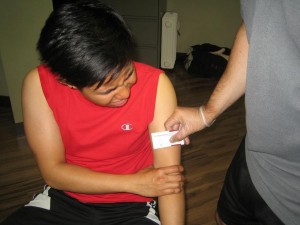A wound is considered to be a break in the continuity of the skin. Wounds may result in the loss of organ function if the wound is deep; bleeding, pain, redness, or swelling and bacterial contamination. It is important to know how to properly manage a wound because a small, lacerated wound may lead to sepsis and death if not properly treated.
The information posted on this page for minor and major wound management is for learning purposes only. To learn to effectively manage serious wounds including abrasions, avulsions, amputations, lacerations and embedded objects sign up for a standard or emergency first aid course today.
First Aid for Wounds
Before caring for skin injuries, it is important to wash the hands clean and wear a sterile glove before touching the wound. Surgical dressing is needed for more serious wounds while you can administer the following first aid for dirty wounds:
- Clean the wound thoroughly under running water with soap.
- Apply pressure for at least 10 minutes on the wound using a wet, sterile gauze or cloth to stop the bleeding while elevating the incised area above the heart at the same time.
- When the bleeding has stopped, you may apply an antiseptic such as povidone iodine around the incised wound and an antibacterial cream in the wound.
- Dress it with a sterile gauze and bandage, putting the edges of the cut together. A band-aid may be used for small wounds.
- Change the dressing every 24 hours or if necessary.
- Watch out for signs and symptoms of infection such as fever and purulent discharge from the wound. Seek a doctor immediately for any untoward manifestations.
Management for Contusions

Contusions and bruises are usually characterized by hemorrhage and swelling that cause black and blue, or red discoloration of the skin.
- Apply cold compress to the bruised area right immediately after the injury. Put the cold pack for 10 minutes while applying pressure. Repeat the procedure every hour. Raise the bruised area above the level of the heart if applicable. This is to stop the bleeding.
- After two days, when the bleeding has totally stopped, warm compresses may be applied to the bruised area to promote blood supply for wound healing.
- Avoid injuries to the area again.
Management for Punctures
- If the object is still in embedded in the skin, remove the object using a sterile forceps. As an alternative, heated tweezers that are allowed to cool and wiped with sterile gauze is used.
- Wash puncture wounds under running water with soap while allowing the wound to bleed.
- Apply antibacterial cream after drying the wound and repeat every day. Cover the wound with gauze if prone to contamination such as the soles of the feet.
- For punctures in vascular areas such as stabs in the chest, never attempt to remove the object. Immobilize the object and bring the patient in the nearest health facility.
References:
Wound Care Center. Different types of wounds. Retrieved on June 27, 2014 from http://www.woundcarecenters.org/article/wound-basics/different-types-of-wounds.

